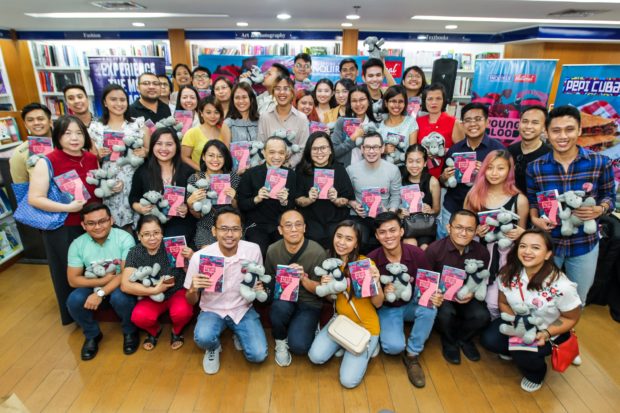
Book Store in Shangri-La Plaza on Saturday. —LEO M. SABANGANII
MANILA, Philippines — Kloyde Caday keeps a clipping of the Young Blood column as a lucky charm.
After his essay “Spaces in togetherness” was printed in the Opinion section of the Inquirer in 2016 — his first-ever piece that was published on a national paper — other works soon followed.
One even made it to “A Duterte Reader: Critical Essays on Rodrigo Duterte’s Early Presidency.”
His parents’ love story
“Spaces” started as a writing prompt. In a workshop, Caday was asked to write about “one thing that you cannot write about.”
The 25-year-old publication officer of Notre Dame of Marbel University couldn’t write his parent’s love story because he never learned how his parents met and fell in love.
But he wrote about it anyway and after many years he realized that not knowing the story didn’t really matter.
He decided that his parents’ devotion to him and his twin brother was enough manifestation of their love for each other.
Caday submitted his essay to Young Blood, hoping to see it published.
“It was my first attempt and I think there’s a certain kind of passport that if you’re published in Young Blood, you’re a writer already,” he told the Inquirer.
But validations aside, Caday said Young Blood was a space for young people.
“Young Blood is also telling them that our voices matter,” he said.
‘Young Blood 7’
Caday flew to Manila to attend the launch of “Young Blood 7,” a collection of the 79 best essays published in the Inquirer’s Young Blood column from 2016 to 2017.
In the 237 pages of the book designed by Ricardo Velarde and with a cover illustration by Glendford Lumbao, 76 contributors wrote about their heartaches, epiphanies, revelations and confessions.
Opinion editor Gibbs Cadiz, Super editor Pam Pastor and Inquirer Books editor Ruel S. De Vera pored over hundreds of contributions until they came up with 79 outstanding essays.
“We’re honored to represent the cutting edge of Filipino writers, we’re honored to represent the writers who will become the great ones,” De Vera said.
“It’s a landmark achievement to appear in this column, which gets 300 submissions every week. You can imagine how many are rejected and how few are accepted. In fact, it’s become kind of a goal to writers to aspire to be published in this section before they turn 30,” De Vera said during the book launch in National Book Store at Shangri-La Plaza, Mandaluyong City.
Few stories see print
In his keynote speech, Inquirer chair Raul Palabrica did the math of getting published in Young Blood: only 4 percent of the 32,200 contributions accumulated in two years had seen print.
“Now you ask, where do the unpublished articles go? We have a big waste basket in the Inquirer,” Palabrica said, drawing laughter from the crowd.
“But only the paper copies are thrown but the e-mailed copies are kept in the database of the Inquirer,” he added.
For writers Elyssa Lopez and Bernadette Nicolas, Young Blood has always been a dream.
Lopez had been a fan of the youth column since high school. Her goal was to have her essay published in Young Blood before she graduated.
“But I never had the story that for me was worth sharing,” she told the Inquirer.
Healing a broken heart
It was after college, while getting over a breakup, that Lopez wrote “Run away” for herself. She wrote about turning to running to heal the hurt.
The essay was printed in Young Blood in April 2017.
Lopez said the publication in Young Blood and the selection of the piece for the book was an honor, as she felt a special connection to the column, sharing its birth year—1994.
A former Inquirer employee, Nicolas had a “short-term goal”—to contribute to Young Blood.
But like Lopez, she didn’t have a story to write.
When she was diagnosed with Bell’s Palsy in 2017, “my
No. 1 priority was to undergo therapy to survive. It was only when I was able to survive the challenge that I felt the need to share that life-changing moment with other people,” Nicolas said.
She turned to Young Blood as a platform to reach out to a bigger audience and share her story of hope.
Time for Young Blood
Urban planner Ragene Andrea Palma loves to put her thoughts in Young Blood.
Her topics range from the frustrations of maneuvering through the traffic-choked streets of Metro Manila to “[my] very strong sentiments on democracy.”
The 28-year-old blogs regularly, and posts her musings on social media, but she still contributes to Young Blood two to three times a year.
In a talk with the Inquirer, she confessed that her daily routine included sitting in a coffee shop and reading this newspaper before starting her work.
“Young Blood sets a particular standard for young writers. It has set the standard for the past years. They really spark readers to think about the particular point that they want society to understand,” she said.
Palma recalled that when her essay about the war on drugs, “In my ‘burgis’ opinion,” was published, she received death threats from thousands of internet trolls.
“I think the first one scared me the most, but [it] gave me the more courage to publish more,” she said.
Why the ‘cutoff age’?
At 28, Palma still has two years left to write for Young Blood. She has plenty of materials, she said.
Though Young Blood is open only to contributors 29 and under, Palabrica encouraged writers to send in contributions.
“Congratulations to the writers. I don’t know why they have the cutoff [age] but that doesn’t mean when you turn 30 you can no longer write. We encourage you to continue to write even after 30,” he said.
“Young Blood 7” is available at National Book Store.